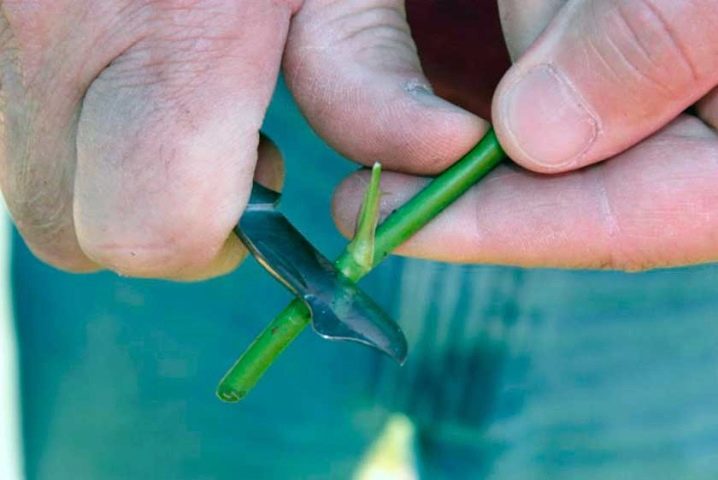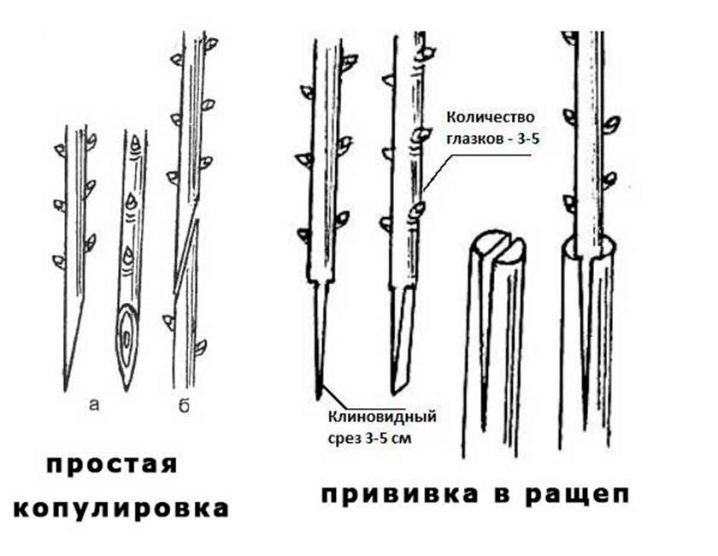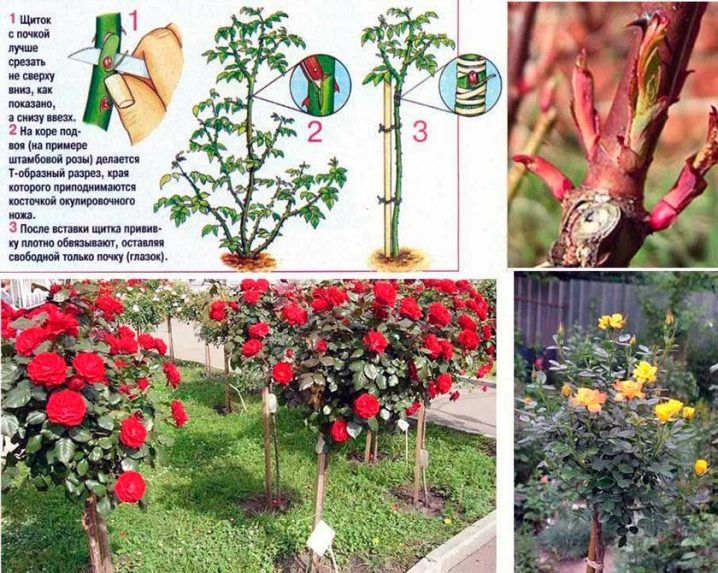How to plant a rose on a rosehip?

Bouquet roses impress others with their appearance, but together with their beauty they are capricious. Almost all plants from the Rosaceae family do not cope well with low temperatures, for which many regions of Russia are famous, clay soil and infertile soil are not suitable for them, and flowers may not tolerate high humidity (as well as lack of water). Fortunately, the lack of ideal conditions for a rose is not a reason to abandon charming flower beds, because you can vaccinate.
It is important to understand that budding and copulation, which everyone hears so often, are varieties of grafting, depending on the material used, and the timing can vary greatly depending on the variety and weather conditions.

Peculiarities
Rose grafting is carried out on a rose hip in order to improve the properties of the plant. This process has many benefits.
-
Because rose hips have increased frost resistance, heat-loving hybrid tea and English roses tolerate Russian winters well - this is a plus for all gardeners.
-
Repaired varieties, for example, Frau Karl Druschki and Prince Max zu Schaumburg after grafting on a bush, they are highly immune to fungal diseases.
-
Dwarf representatives of this genus - "Garden Aroma" and "Rud Morsdag" characterized by a shallow root system, due to which they may lack nutrients and moisture. Rosehip rootstock increases the rose's chances of getting all the minerals it needs from the soil.
-
Floribunda roses, although considered resistant to frost and disease, are very demanding on the amount of sunlight - the selected rootstock with abundant foliage will help varieties such as "Diadem" and "Nicole", avoid burnout in direct light and still get enough energy to form glucose.
-
Climbing varieties are distinguished by late flowering, you can admire flowers earlier by grafting roses on Rósa canína - "Dog Rose", or on Rosa rugosa - "Wrinkled Rosehip".

The main disadvantage of budding is the complexity of the process, which only professionals can handle. Many budding gardeners make a number of mistakes.
-
Do not check the compatibility of the scion - the rose itself, and the rootstock - rosehip.
-
Do not examine the graft for disease. This can lead both to the death of the material and degeneration into roses into rose hips, and to infection of the stock.
-
Immature kidneys are selected.
-
The procedure is carried out in rainy weather, since when water gets in, the rose does not take root.
-
Graft on too old or too young stock.
-
When transplanting a rose, the grafting site is above the soil level. It is correct if it is 3-5 cm deep.

Before planting a rose, a number of steps must be taken.
- Choose a stock and prepare it. The rose hip bush should have a developed root system (this is exactly what it has at 2-3 years old), and have a root collar of at least 1 cm in diameter. For 3-4 days, 3-5 liters of water are poured under the plant, depending on weather conditions, before the procedure, the lower part is cleaned of lateral branches, the ground near the roots is slightly raked, and the neck itself is wiped with a rag, getting rid of dirt.
- Decide on the method of budding. Inoculation can be carried out by both a sprouting and a dormant bud.The latter option is used most often, since it allows the kidney to take root before the onset of frost, but does not allow it to grow, and the sprouting eye is prone to freezing.
- Prepare the scion.

For inoculation with eyes, you must do the following.
-
2-3 weeks before budding, remove the tops of the selected shoots - this accelerates the maturation of the shoots.
-
Cut off the cuttings on the day of grafting, remove leaves, stipules and thorns.
-
Wrap them in a damp cloth before budding and leave in a cool place.
-
Choose a healthy bud from the middle of the cuttings: do not use poorly developed eyes from thick cuttings.
-
Using an eyepiece knife, cut a 3x3 cm square (shield) with a dormant kidney in the center.

To properly bud the plant, refer to the step-by-step instructions.
-
Remove a thin layer of bark from the root collar.
-
Make a deep cutout on it in the shape of the letter "T" with dimensions of 3.5x3.5 cm.
-
Bend the edges slightly and insert the shield with the kidney into the cleft.
-
Fasten the scion to the rosehip with a strapping material so that the bud remains open.
-
Sprinkle the inoculation with damp earth.
-
After 3-4 weeks, check budding and loosen the strapping material.

Copulation scheme
To carry out copulation, it is important to choose annual shoots with already formed buds and decide on the method. Inoculation with a cuttings is:
-
simple, improved - used when the root collar of the dog rose and the cuttings of the rose have the same thickness, or the first is wider than the second;
-
in the cutout, in the split, behind the bark - they are used when the thickness of the rootstock is significantly exceeded.
Simple (Fig. 1, a) and improved (Fig. 1, b)
-
Both on a rosehip and on a varietal rose, you need to make an oblique cut with a sharp knife at an angle of 30 degrees, the length of the cut is 20-25 mm.
-
Press the upper cut tightly to the lower one.
-
Fasten tightly with strapping material.
Improved copulation has additional cuts that provide a more accurate and tight fit of the scion and rootstock to each other. "Tongues" are cut out with a sharp knife, after which the same actions are carried out as for a simple vaccination.

Into the cleft (Fig. 2)
Copulation into the split is carried out according to the instructions.
-
Cut the stock horizontally, make a wedge-shaped cutout with a depth of 1.5-2 cm in it.
-
On a scion with 3-5 buds, a protrusion of up to 5 cm is made.
-
Insert the wedge into the split and secure with a bandage.

For the bark (Fig. 3)
It can be simple and improved, it is used when the bark of the dog rose easily separates from the wood.
-
An oblique cut with a length of 20-30 mm is made on the handle.
-
The stock is trimmed horizontally, a small vertical cut is made at the top of the stock, and the edges of the bark are separated from the wood.
-
The shank is inserted into the stem to the maximum length, after which it is tied tightly.

In the cutout (fig. 4, part 3)
For inoculation in the cutout, proceed as follows.
-
All leaves are removed from the cutting, and its lower end is cut off in the form of a triangular blade.
-
As in the previous method, the rose hip is trimmed horizontally, and a wedge-shaped cut is made in its upper part.
-
The rose is inserted into the stem, and fixed with dressings.

The nuances of vaccination at different times
Grafting a rose on a rose hip requires special care for the chosen season, because the probability of success depends on it.
In the spring
Spring grafting is rightfully considered the best option, because the chances of getting beautiful buds are high this year. It is held during the period of active sap flow, depending on the region and weather conditions, it may fall on the end of May - beginning of June. Cuttings are harvested in advance - in November of last year they are cut, wrapped in plastic wrap or damp cloth and stored in a cool basement or even in a refrigerator. If the harvested shoots have not survived, then it is better to postpone the grafting until summer, because it is difficult to get suitable material in early spring - forcing roses are rather weak and may not take root.
Despite these difficulties, there are many benefits to getting vaccinated in the spring.
-
The dormant buds of the scion have time to take root before the onset of cold weather.
-
If the rose does not take root, there is an opportunity to try again in summer or winter.
-
As mentioned above, there is a high probability of growing a charming bouquet without waiting for next year.
-
Some varieties of roses, such as climbing roses, can only be planted in spring.
-
The process of inoculation itself is greatly facilitated by ascending sap flow: during this period, the bark of the dog rose leaves without much effort.

Summer
Roses grafted in summer almost always survive, but they will have to wait until next year to bloom. Terms of summer budding and copulation: first half of July - first decade of August.

In autumn
The autumn period is rarely isolated, since the vaccination is carried out only during active sap flow, and it ends in the first week of September.
In the fall, only dormant buds can be used, the budding itself can be carried out in sunny weather.

In winter
In winter, you can also graft a rose on a rosehip, but this must be done at home: the room temperature should be optimal for these plants (+ 18 ... 22 degrees), the optimal amount of moisture achieved through drainage, and additional lighting.
Preparation for the procedure begins in December, when the rosehip is brought into a warm room. After 3-4 weeks, the root system is washed with water, after which the roots should be pruned and placed in a pot. A day before copulation, prepared cuttings are brought into a warm room and placed in water mixed with rose growth stimulants.
Copulation itself is carried out according to the standard scheme, but it is not recommended to use budding, since there is no active sap flow.

Follow-up care
Immediately after the vaccination, it is recommended to process the sections with garden varnish - this will accelerate healing and increase the chances of the rose engrafting. To prepare it, you will need paraffin, rosin and vegetable oil in a ratio of 6: 3: 2. The paraffin must be melted, mixed with crushed rosin, brought to a boil and oil added. After the mixture has boiled for another 15-20 minutes, it is left to cool, and then used as directed.
After 2-4 weeks, depending on the method of inoculation, the condition of the rose should be checked - try to separate the rootstock from the scion, with complete accretion, the cutting will easily be removed. If necessary, loosen the strapping materials. For the winter, the dog rose is covered, and in the spring the strapping is removed and the stock is cut off 0.5 cm above the grafting site. The cut is processed again with garden pitch.
After the appearance of 3-4 leaves, it is recommended to pinch the top, forming a branched bush. All the buds that the rose forms should also be removed.

The rose should be watered rarely, but abundantly - up to 20 liters for each bush, depending on the size. It is important to carefully care for the new bush: remove weeds, carry out disease prevention and treat diseased plants in a timely manner.
Fertilization is another important step in growing rose hips. Since roses themselves are very fragile, and after grafting their resistance to adverse conditions deteriorates, they should be fed.
-
Before the first wintering, organic fertilizers are applied: infusion of mullein or chicken droppings.
-
After removing the shelter in the spring, they are fed with ammonium nitrate.
-
Mineral fertilizers - at the end of April.
-
The first year roses do not need fertilizing with nitrogen fertilizers, but the next year it is carried out during the budding period.
-
After the first flowering, complete complex fertilizers with microelements are used.
-
August and September are the time for superphosphate or ash.

Planting roses on rose hips is a tricky task for inexperienced gardeners, but even it can be dealt with without mistakes by following the instructions above. The main thing is to decide on the method of inoculation and the timing of budding and copulation, as well as to study in advance the main nuances of caring for the plant after this procedure: the amount of liquid and the frequency of watering, the fertilization calendar, the preparation of the rose for wintering and maintenance in the spring. This is the only way to get beautiful roses in areas where these flowers usually do not survive.
A detailed description of grafting a rose on a rose hip can be found in the following video.































































The comment was sent successfully.